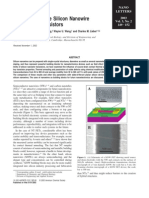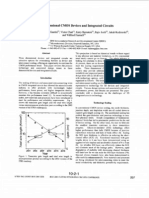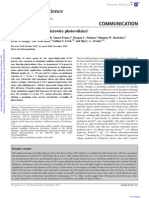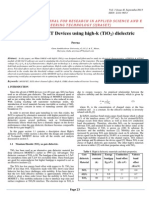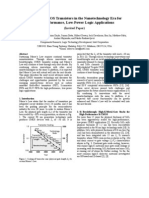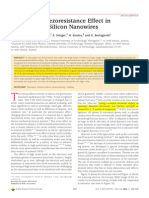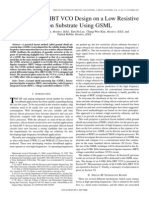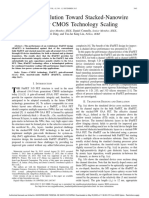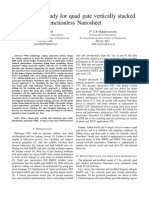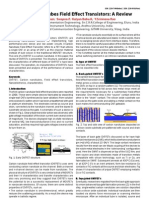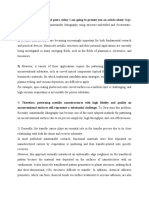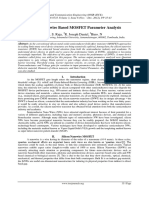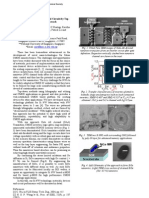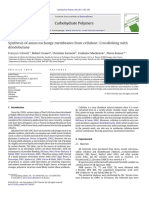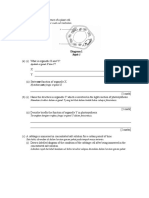Silicon Vertically Integrated Nanowire Field Effect Transistors
Silicon Vertically Integrated Nanowire Field Effect Transistors
Uploaded by
Mas MoCopyright:
Available Formats
Silicon Vertically Integrated Nanowire Field Effect Transistors
Silicon Vertically Integrated Nanowire Field Effect Transistors
Uploaded by
Mas MoOriginal Title
Copyright
Available Formats
Share this document
Did you find this document useful?
Is this content inappropriate?
Copyright:
Available Formats
Silicon Vertically Integrated Nanowire Field Effect Transistors
Silicon Vertically Integrated Nanowire Field Effect Transistors
Uploaded by
Mas MoCopyright:
Available Formats
Silicon Vertically Integrated Nanowire
Field Effect Transistors
Josh Goldberger, Allon I. Hochbaum, Rong Fan, and Peidong Yang*
Department of Chemistry, UniVersity of California, Materials Science DiVision,
Lawrence Berkeley National Laboratory, Berkeley, California 94720
Received January 24, 2006; Revised Manuscript Received February 24, 2006
ABSTRACT
Silicon nanowires have received considerable attention as transistor components because they represent a facile route toward sub-100-nm
single-crystalline Si features. Herein we demonstrate the direct vertical integration of Si nanowire arrays into surrounding gate field effect
transistors without the need for postgrowth nanowire assembly processes. The device fabrication allows Si nanowire channel diameters to be
readily reduced to the 5-nm regime. These first-generation vertically integrated nanowire field effect transistors (VINFETs) exhibit electronic
properties that are comparable to other horizontal nanowire field effect transistors (FETs) and may, with further optimization, compete with
advanced solid-state nanoelectronic devices.
Moores law predicts the pace at which transistor dimensions
are reduced in order to increase the speed and density of
transistors on an integrated circuit. Conventional planar
metal-oxide-semiconductor FETs (MOSFETs), however, are
increasingly facing challenging issues such as short-channel
effects (SCEs), scaling of gate oxide thickness, and increasing
power consumption.
1
To further miniaturize the transistor
while still maintaining control over power consumption,
alternative transistor geometries need to be considered.
1
Silicon nanowire based devices
2,3
and horizontal double-gate
transistors, such as the Fin FET (FINFET),
4-7
have exhibited
high device mobilities and significantly reduced SCEs on
the sub-100-nm scale. The FINFETsa structure based on a
silicon fin sandwiched between two gate electrodesshas
clearly demonstrated that increasing the electrostatic ef-
ficiency of the gate electrode geometry is essential in
reducing power consumption at this size scale. A surrounding
gate geometry is the natural next step for advanced solid-
state nanoelectronic devices, yet with conventional top-down
fabrication processing, it is not easy to realize such a device
architecture with nanoscale features.
Silicon nanowire
2,3,8-11
based transistors exhibit properties
comparable to bulk single-crystalline devices, and with the
recent demonstration of addressing high-density nanowire
circuits,
11
they pose to be very promising building blocks
for future nanoelectronic devices. Typically, silicon nanowire
transistors have a horizontal, planar layout with either a top
or back gate geometry.
2,3,10
However, the amount of energy
and time required to align and integrate these nanowire
components into high-density planar circuits remains a
significant hurdle for widespread application. In-place growth
of vertically aligned nanowires, on the other hand, would in
principle significantly reduce the processing and assembly
costs of nanowire-based device fabrication. Furthermore,
pushing the transistor geometry into the third dimension
could result in ultrahigh transistor densities. Finally the
transport properties of nanowire devices strongly depend on
the nature of the nanowire surface.
2,12
For example, hysteretic
behavior of the threshold voltage is commonly observed due
to the presence of surface and interface charge-trapping states
on the nanowire surface.
3,13
This surface dependence poten-
tially limits the transistor reliability.
To these ends, Si VINFETs in particular are promising
for several reasons. First, transistors having a surrounding
gate structure have been proposed and demonstrated to have
excellent subthreshold behavior due to the high gate coupling
efficiency and a 35% reduction of SCEs compared to double-
gate (FINFET) devices.
14-17
Moreover, the transistor density
per unit area can be significantly increased by fabricating
multiple gate electrodes and source/drain connections along
the length of an individual nanowire, taking advantage of
the high aspect ratio vertical nanowire conduction channel.
The ability to synthesize longitudinal and coaxial hetero-
structure nanowires will allow additional design flexibility,
such as on-chip incorporation of vertical SiGe heterostruc-
tures for on-chip thermoelectric cooling.
9
Furthermore,
embedding the nanowires in low charge trap density SiO
2
would eliminate hysteresis and makes the transistor properties
much more consistent and reproducible. Although ZnO and
CuSCN vertical nanowire transistors have previously been
demonstrated,
18,19
Si VINFETs would be more technologic-
* To whom correspondence may be addressed. E-mail: p_yang@
berkeley.edu.
NANO
LETTERS
2006
Vol. 6, No. 5
973-977
10.1021/nl060166j CCC: $33.50 2006 American Chemical Society
Published on Web 03/30/2006
ally relevant, and more easily integrated using existing
fabrication techniques.
Vertically grown Si nanowires can be used as active
components in a FET design featuring a surrounding gate
geometry. To fabricate Si VINFETs, vertically oriented Si
nanowires were grown on degenerately boron-doped p-type
(F < 0.005 cm) Si(111) substrates as previously de-
scribed.
20
The wires were synthesized via the vapor-liquid-
solid (VLS) growth mechanism in a chemical vapor depo-
sition (CVD) reactor using a SiCl
4
precursor, a BBr
3
dopant
source, and metal nanoparticle growth-directing catalysts.
Figure 1A is a scanning electron microscopy (SEM) image
of Si nanowires grown from 50 nm Au colloids. Transmis-
sion electron microscopy (TEM) analysis confirmed that
these nanowires are single crystalline and grow along the
(111) direction. Si nanowire arrays grown by the above
method exhibit narrow diameter distributions with standard
deviations (typically e9%) equal to those of the colloid
catalysts.
20
Although the nanowires shown in Figure 1a were
grown with Au colloids, similar results have been achieved
using industry-friendly catalyst compositions such as Pt
21
and
Ti.
22
Nanowire length is controlled by the reaction time.
Finally, spatial registration of these nanowires can be
achieved by controlling the position of the nanoparticles
(Figure S1, Supporting Information), as well as using other
methods including nanoimprint lithography
23-25
and e-beam
lithography.
26
As a result, the dimensions and positioning
of the vertical nanowires can be accurately controlled to
create suitable substrates for VINFET fabrication.
Figure 2A is a schematic of the VINFET design. Devices
were fabricated using conventional very-large-scale integra-
tion (VLSI) processing. Vertical silicon nanowire arrays were
thermally oxidized to create uniform SiO
2
layers as dielec-
trics. A typical device has a 20-30 nm diameter Si
nanowire surrounded by 30-40 nm of high-temperature
gate oxide, a Cr metal gate length of 500-600 nm, and
nanowire channel lengths that range from 1.0 to 1.5 m.
The gate-oxide thickness and channel diameter were
obtained from TEM imaging (Figure 1B). Significantly, the
channel diameter can be readily reduced below 5 nm via
conventional high-temperature thermal oxidation. Such high
aspect ratio thin body features are not readily achievable with
conventional lithography. Figure 1C shows a high-resolution
TEM image of a 4.5 nm ultrathin Si channel created in this
manner. Further reduction of the gate oxide thickness could
be accomplished by seeding the nanowires with smaller-sized
nanoparticles, as well as combining thermal oxidation with
SiO
2
etching chemistry. Initial VINFET devices were made
from nanowire arrays catalyzed by low-density nanoparticle
dispersions. Details of the VINFET fabrication process are
described in the Supporting Information. The devices con-
tained anywhere from 8 to 269 nanowires per drain contact
pad. Figures 2B-D are SEM images of a typical device.
Typical drain-source current (I
ds
) vs drain-source voltage
(V
ds
) measurements at various gate voltages (V
gs
) indicated
that B-doped VINFETs behave as accumulation-mode p-type
transistors (Figure 3A). The application of a negative
(positive) V
gs
results in an increase (decrease) of I
ds
, due to
the increase (decrease) of majority hole carriers. The V
gs
value at which the I
ds
is effectively turned on and accumula-
tion begins is defined as the threshold voltage (V
t
). V
t
is more
clearly seen in the plot of I
ds
vs V
gs
at different V
ds
values
for the same device (Figure 3B). The average threshold
voltage for 11 different devices was -0.39 ( 0.19 V (1).
This value is consistent with the expected values for
nanowires with dopant densities around 3 10
16
cm
-3
(Supporting Information).
27
Additionally, no dependence of
the scan rate or direction of V
gs
on the V
t
was observed in
any of our devices. This is illustrated by the lack of hysteresis
in the I
ds
vs V
gs
curves when the V
gs
is varied from negative
to positive to negative values (Figure 3C) at rates varying
Figure 1. Si nanowires: (A) cross-sectional SEM image of
vertically grown Si nanowires off of a Si(111) substrate, scale bar
is 1 m; (B) TEM image of Si nanowire surrounded in a conformal
SiO
2
coating after dry oxidation at 850 C to form the gate dielectric,
scale bar is 75 nm; (C) high-resolution TEM image of a Si nanowire
with an inner diameter that has been reduced to 4.5 nm, scale
bar is 4 nm.
Figure 2. VINFET device configuration: (A) cartoon schematic
of VINFET device (right) fabricated from vertical silicon nanowires
(left). (B) top-view SEM image of a completed VINFET device,
scale bar is 2 m; (C) top-view SEM image of the midsection of
VINFET device, highlighting the conformal gate surrounding the
nanowire channel, scale bar is 1 m. SEM images (B) and (C) are
obtained with a 30 tilt. (D) Cross-sectional SEM image of a
VINFET device. Scale bar is 500 nm. False color is added to image
D, for clarity. In (A) and (D), blue corresponds to the Si source
and nanowire, gray corresponds to SiO
2
dielectric, red corresponds
to the gate material, and yellow corresponds to the drain metal.
974 Nano Lett., Vol. 6, No. 5, 2006
from 0.01 to 3 V s
-1
. This behavior is indicative of a small
number of charge-trapping states in or near the Si/SiO
2
gate
oxide interface and illustrates that consistent, reproducible
transistor performance can be achieved with minimal outside
ambient dependence by embedding these devices in SiO
2
.
The significant figures of merit for transistor performance
include the transconductance (g
m
), the device mobility (),
on-off current ratio (I
on
/I
off
), subthreshold slope (S), and the
drain induced barrier lowering (DIBL). The transconductance
is obtained from the slope of the linear region in the I
ds
vs
V
gs
plot at V
ds
) -1 V. The g
m
for all 11 devices ranged
from 0.2 to 8.2 S. Accurate comparison with other transistor
devices requires normalizing the transconductance with the
effective channel width (W
eff
). Assuming W
eff
is given by
the number of nanowires in each pad multiplied by the
diameter of each nanowire, the normalized transconductance
of our devices ranged from 0.65 to 7.4 S m
-1
. These are
comparable to reported values for high-performance silicon-
on-insulator (SOI) MOSFET (5-12 S m
-1
)
28
and p-type
Si nanowire (0.045-11 S m
-1
)
2,3
devices.
The effective hole mobility of an individual nanowire can
be extrapolated from its transconductance via the equation
) g
m
L
2
/(CNV
ds
), where L is the gate length, N is the
number of nanowires, and C is the gate capacitance for an
individual nanowire. The gate capacitance is described by
the equation C )2
0
SiO
2
L/ln(r
g
/r
nw
), where
0
is the vacuum
permittivity,
SiO
2
is the dielectric constant of the gate SiO
2
,
r
g
is the inner radius of the gate electrode, and r
NW
is the
nanowire radius, assuming a cylindrical channel. However,
these simplified expressions neglect the influence of the top
portion of the nanowire channel which lacks a conformal
gate electrode. In our calculation, we have taken this into
account through numerical integration of the capacitance in
the gated and nongated portions of our device geometry. The
hole mobilities obtained at -2.5V
ds
, range from 7.5 to 102
cm
2
V
-1
s
-1
with an average mobility of 52 cm
2
V
-1
s
-1
.
These hole mobility values are also comparable to those
reported for unfunctionalized p-type silicon nanowires (20-
325 cm
2
V
-1
s
-1
)
2,29
, and within the same order of magnitude
to the best reported values of p-type SOI MOSFETs (180
cm
2
V
-1
s
-1
)
28
. We further note that this estimate represents
a lower limit of our true device mobility, since our model
assumes that every nanowire is in ohmic contact with
negligible contact resistance.
The I
on
/I
off
, and S can be extracted by plotting the I
ds
vs
V
gs
on a logarithmic scale (Figure 3C). The I
on
/I
off
ratio is
the ratio of I
ds
at current saturation (I
on
) to I
ds
at depletion
(I
off
). I
on
/I
off
ranges from 10
4
to 10
6
for all devices. The
minimization of the subthreshold slope is necessary for low
power switching applications in digital electronics. The S
value for a typical device having a 300 gate oxide shell is
120 mV/decade. Although this is approximately double the
theoretical room temperature limit of 60 mV/decade, it is
already much smaller than typical values obtained for
nanowire devices with back-gate or top-gate geometries
(typically >300 mV/decade, with the minimum reported
Figure 3. VINFET device characteristics. (A) I
ds
vs V
ds
at V
gs
) -2.5, -2.0, -1.5, -1.0, and -0.5 V from bottom to top. Inset shows the
full I
ds
vs V
ds
spectrum at V
gs
) -1.5 V. (B) I
ds
vs V
gs
with V
ds
ranging from -2.5 to -0.25 V in 0.25-V steps, from top to bottom,
respectively. The curves collected in (A) and (B) are from a device having 131 nanowires connected in parallel. (C) I
ds
vs V
gs
at -1.25V
ds
(red) and -0.25V
ds
(blue), for a device having 20 nanowires collected in parallel, and measured with V
gs
varying negative to positive to
negative V
gs
values at a 10 mV/s rate. This device has minimal hysteresis, a subthreshold slope of 120 mV/decade, and an I
on
/I
off
ratio
>10
5
. (D) Output characteristics of an inverter circuit (right) fabricated with a p-type VINFET device with 20 nanowires connected in
parallel and an external 200 M resistor. An inverter gain of 28 is determined from the first derivative of this plot with respect to V
in
(left).
Nano Lett., Vol. 6, No. 5, 2006 975
value to be 140 mV/decade).
2,12,13,30
Further reduction of S
can be accomplished by using thinner gate oxides and high-k
materials as the gate dielectric, as S values down to 70 mV/
decade have been experimentally shown in lithographically
defined vertical transistors.
31
Finally, we have been able to successfully fabricate Si
VINFETs with 6.5 nm Si nanowire channel diameters and
gate lengths that range from 300 to 350 nm (Figure S5,
Supporting Information). These ultrathin channel transistor
devices clearly demonstrate the ability to further scale down
the device dimensions. Interestingly, with reduced dopant
density, these 6.5 nm VINFETs exhibit ambipolar behavior.
Such ambipolar behavior has been previously observed for
low-boron-doped silicon nanowires (n
h
) 2 10
15
cm
-3
)
created via a lithographic etching process.
32
The full I
ds
vs V
ds
curves for all devices have a small
nonlinearity at negative V
ds
and are rectifying with an order
of magnitude decrease in current at positive V
ds
(inset in
Figure 3a). Such nonlinearity in the positive and negative
V
ds
is expected as there are two different contacts to the
silicon nanowire: a degenerately doped p
+
Si contact to the
base of the nanowire and a NiSi contact to the medium-
doped Si nanowire drain. This nonlinearity is partly due to
the large resistance of a Schottky barrier at the p-type
nanowire drain. Decreasing the contact resistance will result
in better transistor performance by effectively increasing g
m
,
I
on
/I
off
, and . This could be achieved by tuning the doping
gradient profile along the length of the nanowire, through
the creation of more highly doped silicon in the contact
regions.
33
Nevertheless, the minimization of series contact
resistance at the sub-20-nm scale still remains a significant
challenge for the semiconductor industry.
34
To demonstrate the feasibility of using these devices for
digital logic applications, we have also fabricated an inverter
circuit using resistor-transistor logic. This structure (Figure
3D) was fabricated by connecting a 200 M resistor to one
of our p-type VINFET devices in series. When the input
voltage is ca. -0.9 V, the output voltage switches between
the source (0 V) and the drain voltages (-3.5 V). A large
voltage gain of 28, which is extracted through differentiat-
ing the input and output voltage (left inset in Figure 3D),
indicates that these are high-performance devices and are
suitable for use in microelectronic applications. The ideal
inverter resistor should have a resistance between the on and
off state transistor resistances.
35
Therefore, future on-chip
logic integration is possible by using properly gated VIN-
FETs as resistors can be easily fabricated via source
patterning SOI substrates.
Our prototype Si VINFET devices represent a novel
platform for silicon nanowire electronics that combines the
epitaxial growth of silicon nanowires with top-down fabrica-
tion. These first-generation, unoptimized devices already
show transport properties that are within the same order of
magnitude as standard planar MOSFETs and other nanowire
based devices. Previous device modeling has also suggested
that this device structure is competitive with advanced
nanoelectronic devices, yet the difficulty in lithographically
defining high-aspect ratio vertical Si channels at the sub-
100-nm size scale has hindered the research and implementa-
tion of this architecture. The in-place, vertical growth of
silicon nanowires represents a promising solution to this
problem. The three-dimensional device architecture could
further increase the transistor density through the additional
ability to integrate multiple gates and source/drain connec-
tions along the length of these high aspect ratio channels.
Future optimization of the processing, device geometry, and
dopant concentration, the use of high-k dielectrics, as well
as reduction of the gate length can make these devices
competitive with FINFETs and other current advanced solid-
state devices in the sub-10-nm regime.
Note Added in Proof: During the review of this paper, a
conceptually similar nanowire device was reported (Schmidt,
V.; Riel, H.; Senz, S.; Karg, S.; Riess, W.; Gosele, U. Small
2006, 2, 85-88).
Acknowledgment. We thank Dr. Yi Cui, Dr. Wenjie
Liang, and Dr. Matt Law for helpful discussions. This work
was supported in part by the Beckman Foundation, and the
Department of Energy. J.G. thanks the National Science
Foundation for a graduate research fellowship. A.I.H. thanks
the National Science Foundation for an IGERT graduate
research fellowship. Work at the Lawrence Berkeley National
Laboratory was supported by the Office of Science, Basic
Energy Sciences, Division of Materials Science of the U.S.
Department of Energy. We thank the National Center for
Electron Microscopy, Dr. J. Beeman and Professor E. E.
Haller, and the UC Berkeley Microfabrication laboratory for
use of their facilities.
Supporting Information Available: Descriptions of
nonlithographic positional control of silicon nanowires,
VINFET fabrication procedures, and threshold voltage
analysis. This material is available free of charge via the
Internet at http://pubs.acs.org.
References
(1) Ieong, M.; Doris, B.; Kedzierski, J.; Rim, K.; Yang, M. Science 2004,
306, 2057.
(2) Cui, Y.; Zhong, Z.; Wang, D.; Wang, W. U.; Lieber, C. M. Nano
Lett. 2003, 3, 149.
(3) Duan, X.; Niu, C.; Sahi, V.; Chen, J.; Parce, J. W.; Empedocles, S.;
Goldman, J. L. Nature 2003, 425, 274.
(4) Hisamoto, D.; Lee, W.-C.; Kedzierski, J.; Takeuchi, H.; Asano, K.;
Kuo, C.; Anderson, E.; King, T.-J.; Bokor, J.; Hu, C. IEEE Trans.
Electron DeVices 2000, 47, 2320.
(5) Yu, B.; Chang, L.; Ahmed, S.; Wang, H.; Bell, S.; Yang, C.-Y.;
Tabery, C.; Ho, C.; Xiang, Q.; King, T.-J.; Bokor, J.; Hu, C.; Lin,
M.-R.; Kyser, D. IEDM Technol. Dig. 2002, 251.
(6) Kedzierski, J.; Ieong, M.; Kanarsky, T.; Zhang, Y.; Wong, H. S. P.
IEEE Trans. Electron DeVices 2004, 51, 2115.
(7) Rosner, W.; Landgraf, E.; Kretz, J.; Dreeskornfeld, L.; Schafer, H.;
Stadele, M.; Schulz, T.; Hofmann, F.; Luyken, R. J.; Specht, M.;
Hartwich, J.; Pamler, W.; Risch, L. Solid-State Electron. 2004, 48,
1819.
(8) Wu, Y.; Yang, P. J. Am. Chem. Soc. 2001, 123, 3165.
(9) Wu, Y.; Fan, R.; Yang, P. Nano Lett. 2002, 2, 83.
(10) Cui, Y.; Lieber, C. M. Science 2001, 291, 851.
(11) Beckman, R.; Johnston-Halperin, E.; Luo, Y.; Green, J. E.; Heath,
J. R. Science 2005, 310, 465.
(12) Goldberger, J.; Sirbuly, D. J.; Law, M.; Yang, P. J. Phys. Chem. B
2005, 109, 9.
(13) Wang, D.; Chang, Y.-L.; Wang, Q.; Cao, J.; Farmer, D. B.; Gordon,
R. G.; Dai, H. J. Am. Chem. Soc. 2004, 126, 11602.
976 Nano Lett., Vol. 6, No. 5, 2006
(14) Hergenrother, J. M.; Oh, S.-H.; Nigam, T.; Monroe, D.; Klemens,
F. P.; Kornblit, A. Solid-State Electron. 2002, 46, 939.
(15) Oh, S.-H. Physics and Technologies of Vertical Transistors. Thesis,
Stanford, Palo Alto, CA, 2001.
(16) Oh, S.-H.; Monroe, D.; Hergenrother, J. M. IEEE Electron DeVice
Lett. 2000, 21, 397.
(17) Sharma, A. K.; Zaidi, S. H.; Lucero, S.; Brueck, S. R. J.; Islam, N.
E. IEE Proc.sCirc. DeV. Syst. 2004, 151, 422.
(18) Chen, J.; Klaumuenzer, S.; Lux-Steiner, M. C.; Koenenkamp, R. Appl.
Phys. Lett. 2004, 85, 1401.
(19) Ng, H. T.; Han, J.; Yamada, T.; Nguyen, P.; Chen, Y. P.; Meyyappan,
M. Nano Lett. 2004, 4, 1247.
(20) Hochbaum, A. I.; Fan, R.; He, R.; Yang, P. Nano Lett. 2005, 5, 457.
(21) Garnett, E.; Habas, S.; Yang, P. Unpublished data.
(22) Sharma, S.; Kamins, T. I.; Williams, R. S. J. Cryst. Growth 2004,
267, 613.
(23) Chou, S. Y.; Krauss, P. R.; Renstrom, P. J. Science 1996, 272, 85.
(24) Contreras, A. M.; Grunes, J.; Yan, X. M.; Liddle, A.; Somorjai, G.
A. Catal. Lett. 2005, 100, 115.
(25) Martensson, T.; Carlberg, P.; Borgstroem, M.; Montelius, L.; Seifert,
W.; Samuelson, L. Nano Lett. 2004, 4, 699.
(26) Cui, Y.; Bjork, M. T.; Liddle, J. A.; Sonnichsen, C.; Boussert, B.;
Alivisatos, A. P. Nano Lett. 2004, 4, 1093.
(27) Pierret, R. F., Semiconductor DeVice Fundamentals; Addison-Wesley
Publishing Company, Inc.: Menlo Park, CA, 1996.
(28) Mizuno, T.; Sugiyama, N.; Kurobe, A.; Takagi, S. IEEE Trans.
Electron DeVices 2001, 48, 1612.
(29) Wu, Y.; Xiang, J.; Yang, C.; Lu, W.; Lieber, C. M. Nature 2004,
430, 61.
(30) Jin, S.; Whang, D. M.; McAlpine, M. C.; Friedman, R. S.; Wu, Y.;
Lieber, C. M. Nano Lett. 2004, 4, 915.
(31) Hergenrother, J. M.; Wilk, G. D.; Nigam, T.; Klemens, F. P.; Monroe,
D.; Silverman, P. J.; Sorsch, T. W.; Busch, B.; Green, M. L.; Baker,
M. R.; Boone, T.; Bude, M. K.; Ciampa, N. A.; Ferry, E. J.; Fiory,
A. T.; Hillenius, S. J.; Jacobson, D. C.; Johnson, R. W.; Kalavade,
P.; Keller, R.; King, C. A.; Kornblit, A.; Krautter, H. W.; Lee, J.
T.-C.; Mansfield, W. M.; Miner, J. F.; Morris, M. D.; Oh, S.-H.;
Rosamilia, J. M.; Sapjeta, B. J.; Short, K.; Steiner, K.; Muller, D.
A.; Voyles, P. M.; Grazul, J. L.; Shero, E.; Givens, M. E.; Pomarede,
C.; Mazanec, M.; Werkhoven, C. IEDM Technol. Dig. 2001, 3.1.1
(32) Koo, S. M.; Edelstein, M. D.; Li, Q.; Richter, C. A.; Vogel, E. M.
Nanotechnology 2005, 16, 1482.
(33) Yang, C.; Zhong, Z. H.; Lieber, C. M. Science 2005, 310, 1304.
(34) King, T.-J. Electrochem. Soc. Interface 2005, 14, 38.
(35) Horowitz, P.; Hill, W. The Art of Electronics; Cambridge University
Press: New York, 2001.
NL060166J
Nano Lett., Vol. 6, No. 5, 2006 977
You might also like
- Electrotherapy MCQ PDFDocument2 pagesElectrotherapy MCQ PDFVaibhavi Vaishu40% (5)
- Silicon-Nanowire Mosfets Cmos Compatible Gate-All-Around VerticalDocument4 pagesSilicon-Nanowire Mosfets Cmos Compatible Gate-All-Around VerticalMas MoNo ratings yet
- High-Performance Vertical Gate-All-Around Silicon Nanowire FET With High - Kappa Metal GateDocument5 pagesHigh-Performance Vertical Gate-All-Around Silicon Nanowire FET With High - Kappa Metal GateForgot PasswordNo ratings yet
- Nanowire FET JurnalDocument5 pagesNanowire FET JurnalMuhammad Rizki RamadhanNo ratings yet
- Exploring Strategies To Contact 3D NanoDocument9 pagesExploring Strategies To Contact 3D NanoMatteo LorenzoniNo ratings yet
- Vertical Silicon-Nanowire Formation and Gate-All-Around MOSFETDocument4 pagesVertical Silicon-Nanowire Formation and Gate-All-Around MOSFETMas MoNo ratings yet
- HR Asia, Apr 2011Document4 pagesHR Asia, Apr 2011emediageNo ratings yet
- Chatelaine, Apr 2011Document5 pagesChatelaine, Apr 2011emediageNo ratings yet
- 5164 Final ReportDocument11 pages5164 Final ReportSaurabh ChaubeyNo ratings yet
- Investigation of Charge Plasma Based Nanowire Field Effect Transistor For Sub 5 NMDocument9 pagesInvestigation of Charge Plasma Based Nanowire Field Effect Transistor For Sub 5 NMNeethu SNo ratings yet
- 1556-276X-9-695Document5 pages1556-276X-9-695imanjebeliniaNo ratings yet
- ao-58-30-8221Document6 pagesao-58-30-8221yiwang.liu001No ratings yet
- Three Dimensional CMOS Devices and Integrated Circuits: JakubDocument8 pagesThree Dimensional CMOS Devices and Integrated Circuits: JakubGauri Shankar SinghNo ratings yet
- Carbon Nanotubes For VLSI: Interconnect and Transistor ApplicationsDocument2 pagesCarbon Nanotubes For VLSI: Interconnect and Transistor ApplicationsDhanya Geethanjali SasidharanNo ratings yet
- Technicalarticles Mmwave Siw FilterDocument7 pagesTechnicalarticles Mmwave Siw FilterVikas SinglaNo ratings yet
- High-Performance Si Microwire Photovoltaics : Cite This: DOI: 10.1039/c0ee00549eDocument6 pagesHigh-Performance Si Microwire Photovoltaics : Cite This: DOI: 10.1039/c0ee00549ewangtwothree0% (1)
- JBadding Optoelectronics FiberDocument9 pagesJBadding Optoelectronics FiberFISORGNo ratings yet
- Future MOSFET Devices Using High-K (TiO2) DielectricDocument6 pagesFuture MOSFET Devices Using High-K (TiO2) DielectricIJRASETPublicationsNo ratings yet
- NS3Document4 pagesNS3telecominchargeNo ratings yet
- Robert Chau ICSICT Paper 101904Document5 pagesRobert Chau ICSICT Paper 101904yassirkelNo ratings yet
- Anomalous Piezoresistance Effect in Ultrastrained Silicon NanowiresDocument5 pagesAnomalous Piezoresistance Effect in Ultrastrained Silicon Nanowiresmyemail7159No ratings yet
- Ultra-Small, High-Frequency, and Substrate-Immune Microtube Inductors Transformed From 2D To 3DDocument6 pagesUltra-Small, High-Frequency, and Substrate-Immune Microtube Inductors Transformed From 2D To 3DIntenNo ratings yet
- Mosfet NanowireDocument5 pagesMosfet NanowireftahNo ratings yet
- Carbon Nanotube Field Effect Transistors Fabrication Device Phy PDFDocument10 pagesCarbon Nanotube Field Effect Transistors Fabrication Device Phy PDFDeepu V SNo ratings yet
- Literature ReviewDocument7 pagesLiterature Reviewapi-242278641No ratings yet
- GSML RFICDocument9 pagesGSML RFICRF_RAJANo ratings yet
- 31 - 44 - Single-Layer Substrate Integrated Waveguide Directional CouplersDocument6 pages31 - 44 - Single-Layer Substrate Integrated Waveguide Directional CouplersapertaputraNo ratings yet
- Training For NeuromorphicDocument21 pagesTraining For NeuromorphicAnonymous oQEx3zNo ratings yet
- Fabricación Modificada de Uniones Josephson de Superconductor-Metal Normal-Superconductor para Usar en Un Sintetizador de Forma de Onda ArbitrariaDocument6 pagesFabricación Modificada de Uniones Josephson de Superconductor-Metal Normal-Superconductor para Usar en Un Sintetizador de Forma de Onda ArbitrariajamesNo ratings yet
- Comparative Study of Leakage Power in CNTFET Over MOSFET DeviceDocument6 pagesComparative Study of Leakage Power in CNTFET Over MOSFET DeviceAhmed HussainNo ratings yet
- Junctionless CMOS Transistors With Independent Double GatesDocument3 pagesJunctionless CMOS Transistors With Independent Double GatesBiswajit BeheraNo ratings yet
- Materials Science PaperDocument6 pagesMaterials Science PaperHouIn CheongNo ratings yet
- Nano GabyDocument6 pagesNano GabyMihalache GabrielaNo ratings yet
- How To Bring Nanophotonics To Application - Silicon Photonics PackagingDocument9 pagesHow To Bring Nanophotonics To Application - Silicon Photonics PackagingTony JosephNo ratings yet
- FinFET Evolution Toward Stacked-Nanowire FET For CMOS Technology ScalingDocument6 pagesFinFET Evolution Toward Stacked-Nanowire FET For CMOS Technology ScalingThiago Henrique SantosNo ratings yet
- Performance Study For Quad Gate Vertically Stacked Junctionless NanosheetDocument6 pagesPerformance Study For Quad Gate Vertically Stacked Junctionless NanosheetTarun SinghalNo ratings yet
- Liu 2013Document5 pagesLiu 2013dhook_mmmNo ratings yet
- Surface Modification by Electric Discharge Implemented With Electrodes Composed of Carbon NanotubesDocument6 pagesSurface Modification by Electric Discharge Implemented With Electrodes Composed of Carbon NanotubesDeak Ferenc-JozsefNo ratings yet
- Micromachined Membrane Filters For Microwave and Millimeter-Wave Applications Invited ArticleDocument18 pagesMicromachined Membrane Filters For Microwave and Millimeter-Wave Applications Invited ArticleAbderrahim SmahiNo ratings yet
- Cnt-Fet A ReviewDocument5 pagesCnt-Fet A ReviewEr Ashish BahetiNo ratings yet
- 544 Konuşma.1Document7 pages544 Konuşma.1Selin CulluNo ratings yet
- Improved DC Performances of Gate-All-Around Si-NanDocument9 pagesImproved DC Performances of Gate-All-Around Si-Nansignallab82No ratings yet
- Carbon Nanotube Field Effect Transistors Development and PerspectivesDocument5 pagesCarbon Nanotube Field Effect Transistors Development and PerspectivesSedjali Ali-MustaphaNo ratings yet
- Performance Improvement of FinFET Using Nitride SpacerDocument3 pagesPerformance Improvement of FinFET Using Nitride SpacerseventhsensegroupNo ratings yet
- Comparison of Commercial Planar and Trench SiC MOSFETs by Electrical Characterization of Performance-Degrading Near-Interface TrapsDocument6 pagesComparison of Commercial Planar and Trench SiC MOSFETs by Electrical Characterization of Performance-Degrading Near-Interface TrapsDavid ZhuNo ratings yet
- JSS 1 (2012) P90Document5 pagesJSS 1 (2012) P90Chomsatin AmaliaNo ratings yet
- Fabrication and Characterization of Vertically Stacked Gate-Ail-Around Si Nanowire Fet ArraysDocument4 pagesFabrication and Characterization of Vertically Stacked Gate-Ail-Around Si Nanowire Fet ArraysRàhuł MathiasNo ratings yet
- Seminar Report: Submitted By: Amena Tarique (16BEC027)Document25 pagesSeminar Report: Submitted By: Amena Tarique (16BEC027)Moon SkyNo ratings yet
- 5 NM) Gate-All-Around CMOS Devices: High-Performance Fully Depleted Silicon Nanowire (DiameterDocument4 pages5 NM) Gate-All-Around CMOS Devices: High-Performance Fully Depleted Silicon Nanowire (DiameterRàhuł MathiasNo ratings yet
- Directional CouplerDocument4 pagesDirectional CouplerShrutiAwasthiNo ratings yet
- Segmented Channel MosfetDocument2 pagesSegmented Channel MosfetcreativityyNo ratings yet
- Mosfet de NanohiloDocument9 pagesMosfet de NanohiloRodrigo LoboNo ratings yet
- Nanowire Transistors by J P Colinge PDFDocument257 pagesNanowire Transistors by J P Colinge PDFSupriya SajwanNo ratings yet
- Reference PaperDocument6 pagesReference PaperAbhishek GargNo ratings yet
- Nara@ime.a-Star - Edu.sg: Si Nanowire CMOS Transistors and Circuits by Top-Down Technology ApproachDocument1 pageNara@ime.a-Star - Edu.sg: Si Nanowire CMOS Transistors and Circuits by Top-Down Technology ApproachDinesh SinghNo ratings yet
- Millimeter-Wave Silicon-on-Glass Integrated Tapered AntennaDocument4 pagesMillimeter-Wave Silicon-on-Glass Integrated Tapered AntennaAbdul AzizNo ratings yet
- Alpha Particle Effect On Multi-Nanosheet Tunneling Field-Effect Transistor at 3-nm Technology NodeDocument11 pagesAlpha Particle Effect On Multi-Nanosheet Tunneling Field-Effect Transistor at 3-nm Technology Node전종욱No ratings yet
- Flexible High-Output Nanogenerator Based On Lateral Zno Nanowire ArrayDocument5 pagesFlexible High-Output Nanogenerator Based On Lateral Zno Nanowire ArraymirelamanteamirelaNo ratings yet
- H. Liu, D. K. Mohata, A. Nidhi, V. Saripalli, V. Narayanan and S. DattaDocument2 pagesH. Liu, D. K. Mohata, A. Nidhi, V. Saripalli, V. Narayanan and S. DattaMas MoNo ratings yet
- Nanoelectronics and at Imec: More-than-MooreDocument52 pagesNanoelectronics and at Imec: More-than-MooreMas MoNo ratings yet
- Fabrication of Nanowire MOSFETS: Virginia Polytechnic InstituteDocument14 pagesFabrication of Nanowire MOSFETS: Virginia Polytechnic InstituteMas MoNo ratings yet
- Logic Gates With A Single Graphene Transistor: Roman Sordan Floriano Traversi Valeria RussoDocument4 pagesLogic Gates With A Single Graphene Transistor: Roman Sordan Floriano Traversi Valeria RussoMas MoNo ratings yet
- Vertical Silicon-Nanowire Formation and Gate-All-Around MOSFETDocument4 pagesVertical Silicon-Nanowire Formation and Gate-All-Around MOSFETMas MoNo ratings yet
- Master of Science in ChemistryDocument9 pagesMaster of Science in ChemistryBry AnNo ratings yet
- BrochureDocument36 pagesBrochureSahil VoraNo ratings yet
- Silver Streaks On PlasticsDocument3 pagesSilver Streaks On PlasticsvkmsNo ratings yet
- BiomoleculesDocument2 pagesBiomoleculesDivyansh BhandariNo ratings yet
- Internship Report FFBLDocument33 pagesInternship Report FFBLmuhammadasif435No ratings yet
- Production of Ammonia by Haber Bosch ProcessDocument5 pagesProduction of Ammonia by Haber Bosch ProcesszahidNo ratings yet
- Research ArticleDocument5 pagesResearch Articlekamransaeed668No ratings yet
- SulfurDocument1 pageSulfurAecille VillarNo ratings yet
- Haldor Topsøe Catalyzing Your Business: Aldo PeirettiDocument49 pagesHaldor Topsøe Catalyzing Your Business: Aldo PeirettiFranz MideberNo ratings yet
- Plasma Immersion Ion Implantation (PIII) Process - Physics AND TechnologyDocument20 pagesPlasma Immersion Ion Implantation (PIII) Process - Physics AND TechnologyHemant SinghNo ratings yet
- ASTM D1142 - 95 (R2012) - Water Vapor Content of Gaseous Fuels by Measurement of Dew-Point TemperatureDocument11 pagesASTM D1142 - 95 (R2012) - Water Vapor Content of Gaseous Fuels by Measurement of Dew-Point TemperaturegisegiseNo ratings yet
- Cryogenic EngineeringDocument2 pagesCryogenic EngineeringVishvesh T SNo ratings yet
- Week2 Internal FlowDocument45 pagesWeek2 Internal FlowJose Carlos Obregón MartinezNo ratings yet
- Jurnal IodiumDocument6 pagesJurnal Iodiumhasanahtuyetha0207No ratings yet
- Synthesis of Anion Exchange Membranes From Cellulose: Crosslinking With DiiodobutaneDocument5 pagesSynthesis of Anion Exchange Membranes From Cellulose: Crosslinking With DiiodobutaneNeni HernawatiNo ratings yet
- SAMPLE ISO Course Syllabus NEWDocument10 pagesSAMPLE ISO Course Syllabus NEWkhansNo ratings yet
- Coa of Purified WaterDocument5 pagesCoa of Purified WaterRavi Yadav100% (1)
- EMM Lab ManualDocument4 pagesEMM Lab Manualbhajneets2005100% (1)
- Chapter 8, 11 Heath Textbook Chemistry 11Document6 pagesChapter 8, 11 Heath Textbook Chemistry 11Venus WangNo ratings yet
- Hemoglobin: Portrait of A Protein in ActionDocument32 pagesHemoglobin: Portrait of A Protein in Actionraanja2No ratings yet
- MCB 421Document9 pagesMCB 421olamideNo ratings yet
- Esso Xd-3 Extra Esso Xd-3 Extra: Premium Heavy Duty Engine Oil Premium Heavy Duty Engine OilDocument6 pagesEsso Xd-3 Extra Esso Xd-3 Extra: Premium Heavy Duty Engine Oil Premium Heavy Duty Engine OilAbdulwahed alsafanyNo ratings yet
- 2021 H2 JC1 Promo Section C QnsDocument16 pages2021 H2 JC1 Promo Section C QnsFelysia DianniNo ratings yet
- Demystifying Cleaning and Sanitizing of Food ContactDocument44 pagesDemystifying Cleaning and Sanitizing of Food ContacthanaNo ratings yet
- 2D NMR PrinterfriendlyDocument50 pages2D NMR PrinterfriendlySundararaju BaskerNo ratings yet
- Final Poster Rishab JainDocument1 pageFinal Poster Rishab Jainapi-327973044No ratings yet
- Novel SynthesisDocument4 pagesNovel SynthesisSamNo ratings yet
- PO4-Phosphate Buffers-RECIPES - Preparation of PH Buffer Solutions, PH1.0-PH13.0 - Recipes Ex Web-Delloyd's Lab Tech - Hompage (14!02!18pdf)Document5 pagesPO4-Phosphate Buffers-RECIPES - Preparation of PH Buffer Solutions, PH1.0-PH13.0 - Recipes Ex Web-Delloyd's Lab Tech - Hompage (14!02!18pdf)PinoteDiegoNo ratings yet
- Diagram 1 Shows The Structure of A Plant Cell.: Rajah 1Document9 pagesDiagram 1 Shows The Structure of A Plant Cell.: Rajah 1mishaNo ratings yet







